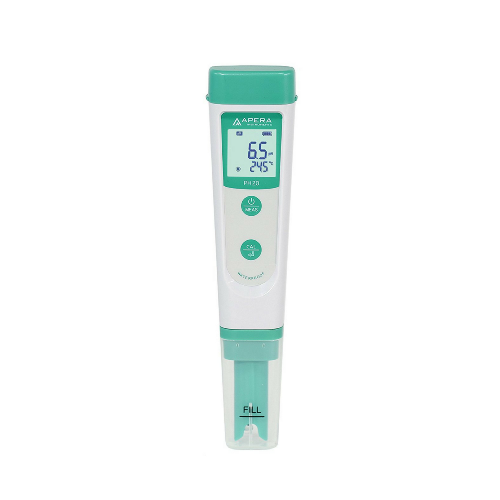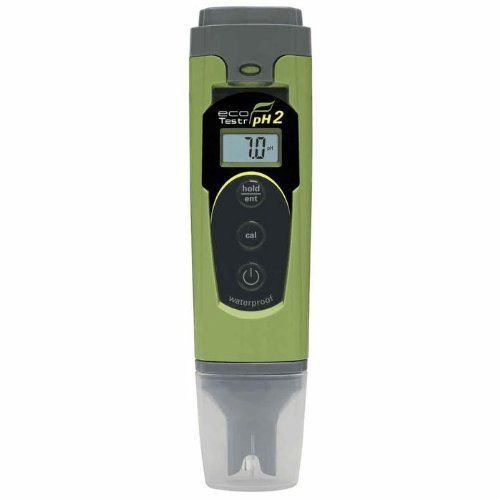The Best pH Meters For Hydroponics

If you’re new to growing hydroponically you may not appreciate the importance of controlling your pH. It’s not an obvious variable to consider because it’s not clear to see like lighting or ventilation. You wouldn’t be the first, you won’t be the last.
If you’re a more experienced grower perhaps you have a direct understanding of how neglecting to monitor your pH levels negatively affects your plants.
In this article we’re going to discuss why measuring the pH of your nutrient solution is important, the equipment you’ll need to do it and how to look after it. Lastly, we’ll give you few examples of the best pH meters on the market in 2017.
The best ph meters for hydroponics
You're curious about pH and its importance it plays in keeping your plants healthy. Why does one species need acidic conditions and another species alkaline? The answers to the universe lie in nutrient lockout. I've written a great article on everything you need to know about nutrient lockout so we’ll keep this fairly info-lite.
Even when feeding your plants with the correct macro and micronutrient ratios, the plant will absorb them at differing rates. This leads to a build-up of some elements in the water and, over time, the effect is magnified. The accumulation will eventually start to have a negative effect on the pH of your nutrient solution.
Plants are comfortable in a relatively narrow pH range, outside of which they start to slow down their absorption rates of essential nutrients. This slowing down will eventually result in complete cessation. There’s no perfect pH level to grow at as all elements have different optimal ranges but most of these overlap between 6.0 and 7.5. You must constantly check the pH level of your nutrient solution and to do that you need to buy a pH meter. Before I go any further, here are the best ones at a relatively cheap price.
The best cheap ph meters
What is pH?
We define pH as the concentration of hydrogen ions in a solution. If there are a lot of hydrogen ions in the nutrient solution then the pH will be low and alternatively, if there are few hydrogen ions in the nutrient solution, it will have a high pH.
The actual formula for calculating pH is:
pH=-log[H+] concentration
|
Hydrogen Ion Concentration |
pH |
Solutions with the same pH |
|
0.1M |
1 |
|
|
0.01M |
2 |
Cola and orange juice |
|
0.001M |
3 |
|
|
0.0001M |
4 |
|
|
0.00001M |
5 |
Black coffee |
|
0.000001M |
6 |
|
|
0.0000001M |
7 |
Pure water |
|
0.00000001M |
8 |
|
|
0.000000001M |
9 |
Baking soda |
|
0.0000000001M |
10 |
|
|
0.00000000001M |
11 |
|
|
0.000000000001M |
12 |
Household bleach |
|
0.0000000000001M |
13 |
Oven cleaner |
M = molar, and is the unit concentration is measured in.
This is extra knowledge to suppliment your curious mind, it won’t affect how you go about choosing your pH meter. If you don’t understand what I'm talking, it’s all good.
How do pH meters work?
Anyone who’s done basic chemistry has used litmus paper before. If you haven’t, it’s a small strip of paper that changes color when dipped into a solution. The final color can then be compared against a reference chart as rough verification of the solution’s pH.
The benefits of using pH strips are their ease of use and the minimal costs. You can’t get much more simple than dipping a piece of paper into a liquid and deciding its color. There’s no need for calibration or looking after the equipment over months or years. It's reflected in the price. Buying pH strips is significantly cheaper than buying a digital pH meter, especially in the short term.
The disadvantage of pH strips are inaccuracies, colorblind issues, and regular purchasing. There will always be general inaccuracies when interpreting colors because of slight subjective biases, but it can be impossible for someone who’s colorblind. Depending on your level of colorblindness, pH strips may not even be an option. Although pH strips are cheaper than digital meters, over an extended period of time the costs will balance out with the regular buying of new batches.
However, there is another method and most hydroponic growers use them, they're digital pH meters. The concentration of hydrogen ions in a solution correlates with the electrical potential of the solution too. Normally, a glass electrode sits in a solution with a known pH (typically, potassium at pH 7) and another electrode sits in the solution of unknown pH.
The pH meter then calculates the voltage produced by the hydrogen ions in both the known solution and the unknown solution and compares each, giving a reading for the unknown solution.
There’s slightly more to it than that - if you want a more detailed explanation, here’s the source material.
If the pros outweigh the cons for you and you’d like to know where to purchase some pH strips from, check these out.
Advantages of digital pH meters
Just because pH strips are easy to use doesn’t mean digital pH meters are difficult, in fact, they're probably easier. As long as your unit is calibrated correctly and you’ve looked after it, all you need to do is read the number it displays on the screen. The accuracy this provides is much better than having to figure out the color of a piece of paper as all the ambiguity is removed. There’s peace of mind for everyone, but even more so if you have issues determining colors. If you decide to buy a top-end pH meter you’ll be investing in the equipment long-term and won't have to spend money for a long time. You don't waste money on failed crops either.
Disadvantages of digital pH meters
Digital pH meters need you to care for them. What they give you in accuracy is only managed through great maintenance and this can be tricky if you’ve never done it before. There are, of course, instructions packaged with the meter and tutorials online to help you with this but it can put some people off regardless. The cost of high-quality meters is expensive and some people don’t have the cash flow to be spending big money but, as we all know, hydroponics is an expensive hobby to have.
How to calibrate the pH meter
To continue having accurate measurements, you need to regularly calibrate your pH meter - it’s recommended you do this a minimum of once a week. Calibrating the electrodes reminds them exactly what pH levels look like.
It’s important to always read the manual that comes with your unit as each is different in their functioning. You need at least two buffer solutions to calibrate your meter, both of which have known pH levels. The common buffer pH levels are 4.01, 7.00 and 10.00.
The first step is usually recording the temperature on your device, this is because temperature directly affects the pH and may give you skewed results. Depending on how sophisticated the meter is, it will be able to take its own temperature measurements but, if not, you’ll need to dip a separate temperature probe into the solution.
Put the electrode into the buffer pH 7.00 solution and calibrate it, make sure you don’t hit the electrode off the bottom of the container. Tell your meter to calibrate and once it’s recognised the solution, remove it and rinse with distilled water into an empty vessel. This removes any contaminants from the electrode.
If your nutrient solution is intended to be more acidic then repeat the above step with the pH 4.01 buffer solution. If your nutrient solution is more alkaline, use the pH 10.00 buffer solution. If you want to be able to record over a wide range of pH levels, calibrate with both in a three-point calibration. Remember to rinse with distilled water after each use.
Buffer solutions with a high pH are prone to absorb carbon dioxide from the atmosphere, so remember to constantly cover the solution up with the lid and make sure it’s as fresh as possible when you use it to avoid the calibration pH going AWOL.
Once you’ve completed these steps, you’re ready to test your nutrient solution. This is a broad overview of how to proceed so, again, remember to read the instruction manual before taking the plunge.
Keeping your pH meter healthy
Aside from calibrating your pH meter, there are several steps you should take to ensure its well-being is maintained for as long as possible. This way you’ll save money in the long run. Store your meter in the storage solution provided to prevent the electrodes from drying out. Hydration of the glass bulb is important in determining the voltage of the pH you’re testing and can take three to four hours after submersion.
Avoid touching the electrodes at all costs because the grease from your hands will disrupt the electrochemical gradient necessary for precise results.
Best brands of pH meters
It’s universally agreed the two best brands on the market at the moment are Hanna and Bluelab pH meters. A lot of university laboratories use Bluelab equipment so you know they’re going to be at the top end of the range and certainly suitable for hobby hydroponic growers. They’re more expensive than most brands but if you look after them pproperly you won’t need to buy another for a long time.
There are predominantly two types of pH meters you’re likely to use in a hydroponic setup. One is the handheld pen and the other is a combo unit. The pen is a more simple device and only measures the pH of a solution. The combo pH meter has a few other components as well as the pH meter itself, including a thermometer.
have you seen our other Articles on hydroponics?
The Basics Of Hydroponics | The Kratky Method | Types Of Hydroponics | Deep Water Culture | The Drip System | The Wick System | Lighting In Hydroponics | The Ebb And Flow System | Nutrient Film Technique | Nutrients For Plant Growth | Ventilation For Hydroponics | Growing Media Used In Hydroponics | Hydroponics | The Best Way To Cure Root Rot | How To Choose A Grow Tent | The Best LED Grow Lights | Everything You Need To Know About Nutrient Lockout | The Best Air Pumps For Hydroponics | The Best PH Meters For Hydroponics | What Mom Never Told You About The GH Dual Diaphragm Air Pump |



Terms & Conditions
Subscribe
Report
My comments